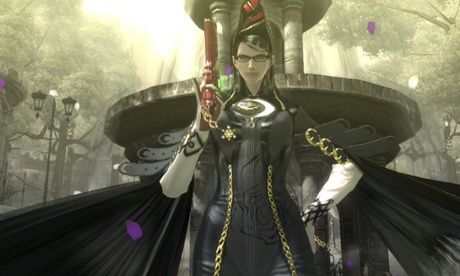
“Strong female character” is one of the most loaded phrases in video game design. Often slung at any female protagonist who does more than act as a prize for a conquering male hero, its meaning is ambiguous, its usage often prescriptive and controlling. And sometimes it points in entirely the wrong direction.
Lara Croft is perhaps the most famous woman in gaming. Since the original Tomb Raider arrived in 1996, the character has attracted criticism for her physical appearance – so when the most recent release in the series gave her a realistically proportioned body, the new Lara was praised as a more relatable hero. Removing the over-sized breasts and teeny, tiny waist is apparently all that was needed for the character to evolve from sex object to admirable “survivor”.
In stark contrast, however, is the eponymous star of Bayonetta, a hyper-kinectic action adventure from cult Japanese developer, Platinum Games.
Bayonetta is a powerful witch who battles angels, shoots from her gun-heeled shoes and transforms her hair into hellish demons that rip apart her foes. She is a super-idealised character who has all the ostensibly negative physical features of the old Lara, but whose body and sexuality are embraced and used as a weapon to control and manipulate her enemies.
Sexuality and aggression
At first glance, it’s easy to dismiss Bayonetta as just another male fantasy, another female character to be ogled and abused. But, in reality, the character is a power trip for and about women. Through her overt sexuality, her acceptance and love of her own body, Bayonetta makes the men in the game (and perhaps many of those playing) uncomfortable. During the story sequences, male agents of God become stuttering fools in her presence; she owns and shows off her body, she dances and straddles her foes; the camera often points upwards so that she is in effect thrusting her vagina into the face of the player.
While Bayonetta fully embraces her sexuality, in the Tomb Raider reboot, Lara fades into her grueling, grey surroundings. Her focus throughout the game is Samantha, another survivor of the shipwreck that brings Croft to the game’s savage island setting, and everything suggests that their relationship is more than just a friendship; lingering smiles, gentle touches and the resilience with which they protect and defend each other. The game’s writer, Rhianna Pratchett, has even hinted in interviews that she would have been interested in making the character gay.
This was never acted upon. Perhaps the development team felt that her sexuality had to be repressed in order for her to become an acceptable female hero; perhaps she needed to remain “available” to the game’s male fanbase. Whatever, the carefully staged romantic tensions between the two are left incomplete and unrealised.
Femininity, gameplay and narrative
Despite appearances, Bayonetta rarely panders to the imagined male audience. Yes, she’s ridiculously proportioned and scantily clad for most of the game, but far from being an object, she is portrayed as having complete autonomy and control over her body and femininity.
Lara Croft has had to change to fit into the “strong female character” role, whereas Bayonetta whips it into submission and makes no apology for her love of lipstick, high heels or, indeed, herself. Everything about Bayonetta is determined by her womanhood and femininity, yet she remains dominant throughout: during the course of the game she spanks angels, submits them to humiliating torture attacks and transforms into a panther, clad with painted red claws and gold jewellery. Bayonetta is a powerful woman, she is not powerful in spite of being a woman.
For all the praise of Lara’s growth throughout Tomb Raider, that maturation process is arguably nothing more than a jarring graduation from doubting, guilt-ridden girlhood into lean, mean, psychopathy. Her first kill is supposed to devastate us as it apparently devastates Lara but, almost immediately, we’re thrust back into a game which rewards us for killing. Lara is a character who is even uncomfortable in her own story.
Parents, development and the ‘survivor’
Tomb Raider’s tagline tells us, “a survivor is born” and Lara is put through horrific abuse before she can transcend from naïve youngster to hardened survivor. But within games and wider media, the “survivor” is a tired trope, women are survivors where men are heroes; they overcome rather than succeed.
Lara’s constant doubts are always quelled by a reassuring, grumbled platitude from a male character, Conrad Roth, who takes on a father role. Only through Roth’s teaching and physical protection can Lara be born again as “survivor”. Throughout the game he whispers to her, “You can do this. You’re a Croft.” By virtue of her familial name, inherited from her father, Lara is granted the intelligence, agility and strength to survive the intense battering the game puts her through.
Family also impacts Bayonetta’s story, but in a very different way. When, during one sequence, a toddler named Cereza addresses her as “mummy”, the titular character is plunged into perceived motherhood. Reluctantly, she cares for the child but remains the same lewd, extravagant and powerful woman we’ve come to know.
It’s later revealed that, through a twist in time and reality, Cereza is in fact Bayonetta as a child. It’s strange but the message is interesting: by giving two parts of the same person different names, the line is drawn between womanhood and childhood, the sexed and non-sexed subject. Whereas Lara develops from woman to “survivor”, Bayonetta develops from child to woman. Whatever the intentions, Lara’s development casts women as synonymous with vulnerability whereas in Bayonetta’s development, vulnerability is left far behind.
Bayonetta presents us with a truly empowering woman who’s unapologetically feminine, sexual and confident. Dismissed by many as an objectified fantasy, she is a woman without compromise who refuses to be ashamed of her body, who in one sequence giggles seductively as she grasps the pulsating heart of a heaven-sent deity and asks: “Do you want to touch me?”

